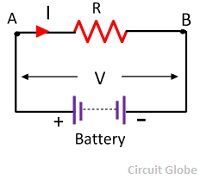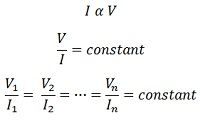When an electric potential difference (V) is applied across a conductor as shown in the figure below, some current (I) flows through it. The flow of current is opposed by the resistance of the conductor and circuit. The relation between voltage, current and resistance is explained by the ohm’s law.
Ohm’s laws state that the current through any two points of the conductor is directly proportional to the potential difference applied across the conductor, provided physical conditions i.e. temperature, etc. do not change. It is measured in (Ω) ohm.
Mathematically it is expressed as
In other words, Ohm’s law can also be stated as;
The ratio of the potential difference across the end point of the conductor to the current flowing between them is always constant, but the physical conditions of the conductor i.e. temperature, etc. remain same.
This constant is also called the resistance (R) of the conductor (or circuit)
It can be written as
In a circuit, when current flows through a resistor, the potential difference across the resistor is known as voltage drops across it, i.e., V = IR.
Limitations of Ohm’s Law
- Ohm’s law is not applicable in unilateral networks. Unilateral networks allow the current to flow in one direction. Such types of network consist elements like a diode, transistor, etc.
- It is not applicable for the non-linear network. In the nonlinear network, the parameter of the network is varied with the voltage and current. Their parameter likes resistance, inductance, capacitance and frequency, etc., not remain constant with the times. So ohms law is not applicable to the nonlinear network.
Ohm’s law are used for finding the resistance of the circuit and also for knowing the voltage and current of the circuit.





Good.
Ok thanks for your valuable feedback
thank you….
Good nice
thank you